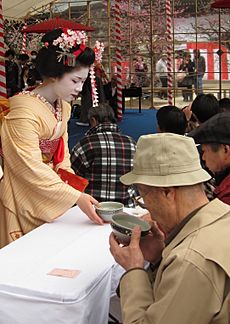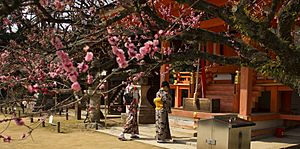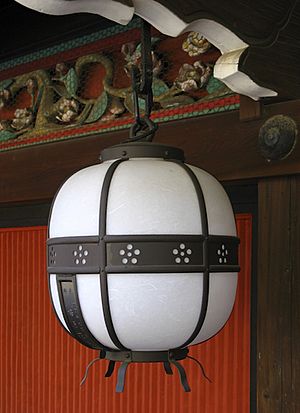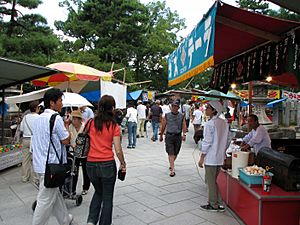Kitano Tenmangū facts for kids
Quick facts for kids Kitano Tenmangū北野天満宮 |
|
|---|---|

The honden, or main building.
|
|
| Religion | |
| Affiliation | Shinto |
| Deity | Sugawara no Michizane |
| Festival | Reitaisai (August 4th) |
| Type | Tenmangū |
| Location | |
| Location | Hakuraku-chō, Kamigyō-ku, Kyoto |
| Architecture | |
| Architectural style | Gongen-zukuri |
| Date established | 947 |
Kitano Tenmangū (北野天満宮, Kitano-Tenmangu) is a famous Shinto shrine located in Kamigyō-ku, Kyoto, Japan. It is a very important place dedicated to Sugawara no Michizane, a brilliant scholar and politician from ancient Japan. Many people visit this shrine, especially students, to pray for success in their studies and exams.
History of Kitano Tenmangū
The Kitano Tenmangū shrine was first built in the year 947. It was created to honor the spirit of Sugawara no Michizane. Michizane was a smart government official, writer, and poet. He was sent away from the capital because of political tricks by his enemies, the Fujiwara clan. After he died, people believed his spirit was angry. The shrine was built to make his spirit happy and peaceful.
During the early Heian period, the shrine became very important to the emperors. In 965, Emperor Murakami started sending special messengers to report important events to the main kami (gods) of Japan. These messengers brought gifts called heikaku to 16 shrines. Later, in 991, Emperor Ichijō added three more shrines to this list, and Kitano Tenmangū was one of them.
From 1871 to 1946, Kitano Tenmangū was officially recognized as a Kanpei-chūsha (官幣中社). This meant it was a top-ranked shrine supported by the government.
Tenjin: The Deity of Learning
The shrine is dedicated to Michizane. In 986, Michizane was made into a god and given the special title of "Tenjin". This title means "heavenly deity." Tenjin is now known as the god of scholarship, literature, and learning.

The shrine grounds are famous for their many plum trees. These trees have beautiful red and white ume (plum blossoms). Plum blossoms were Michizane's favorite flowers. When the plum trees bloom, usually in late winter, the shrine becomes very crowded with visitors.
The Plum Blossom Festival (梅花祭, baikasai) is held every year on February 25th. This date marks the day Michizane died. An outdoor tea ceremony (野点, nodate) is a special part of the festival. Geiko (geisha) and apprentice maiko from the nearby Kamishichiken district serve tea and traditional Japanese sweets (wagashi) to thousands of guests. This plum festival has been celebrated on the same day for about 900 years. The outdoor tea ceremony itself started in 1952. It was inspired by a historic tea ceremony held at the shrine by the famous leader Toyotomi Hideyoshi.
Kitano Tenmangū is very popular with students. They come to pray for good luck and success in their school exams. This is because the god Tenjin, who is Michizane, was a man of great knowledge and literature during his life.
On the 25th of every month, the shrine also hosts a lively flea market. This market is very well-known. There's a famous saying in Kyoto about the weather and these markets: "Fair weather at the Tōji market means rainy weather at the Tenjin market." This proverb talks about Kyoto's often changing weather, as there is another similar market at Tō-ji temple.
See also
 In Spanish: Kitano Tenman-gū para niños
In Spanish: Kitano Tenman-gū para niños
- List of Shinto shrines
- Twenty-Two Shrines
- Three Great Tenjin Shrines





